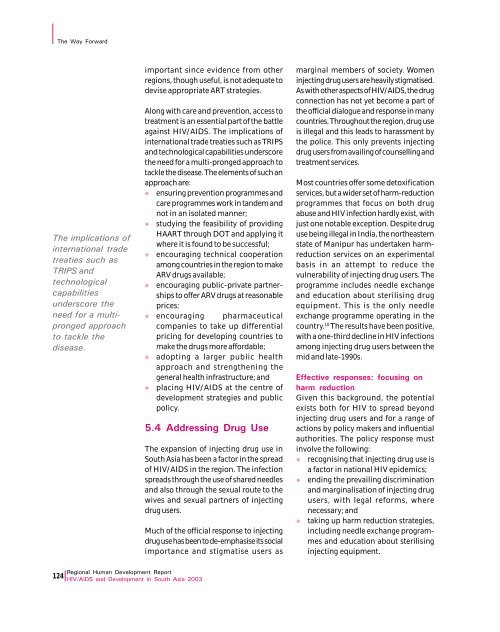Download Report - UNDP Asia-Pacific Regional Centre - United ...
Download Report - UNDP Asia-Pacific Regional Centre - United ...
Download Report - UNDP Asia-Pacific Regional Centre - United ...
Create successful ePaper yourself
Turn your PDF publications into a flip-book with our unique Google optimized e-Paper software.
The Way orwardThe implications ofinternational tradetreaties such asTRIPS andtechnologicalcapabilitiesunderscore theneed for a multiprongedapproachto tackle thedisease.important since evidence from otherregions, though useful, is not adequate todevise appropriate ART strategies.Along with care and prevention, access totreatment is an essential part of the battleagainst HIV/AIDS. The implications ofinternational trade treaties such as TRIPSand technological capabilities underscorethe need for a multi-pronged approach totackle the disease. The elements of such anapproach are:l ensuring prevention programmes andcare programmes work in tandem andnot in an isolated manner;l studying the feasibility of providingHAART through DOT and applying itwhere it is found to be successful;l encouraging technical cooperationamong countries in the region to makeARV drugs available;l encouraging public-private partnershipsto offer ARV drugs at reasonableprices;l encouraging pharmaceuticalcompanies to take up differentialpricing for developing countries tomake the drugs more affordable;l adopting a larger public healthapproach and strengthening thegeneral health infrastructure; andl placing HIV/AIDS at the centre ofdevelopment strategies and publicpolicy.5.4 Addressing Drug UseThe expansion of injecting drug use inSouth <strong>Asia</strong> has been a factor in the spreadof HIV/AIDS in the region. The infectionspreads through the use of shared needlesand also through the sexual route to thewives and sexual partners of injectingdrug users.Much of the official response to injectingdrug use has been to de-emphasise its socialimportance and stigmatise users asmarginal members of society. Womeninjecting drug users are heavily stigmatised.As with other aspects of HIV/AIDS, the drugconnection has not yet become a part ofthe official dialogue and response in manycountries. Throughout the region, drug useis illegal and this leads to harassment bythe police. This only prevents injectingdrug users from availing of counselling andtreatment services.Most countries offer some detoxificationservices, but a wider set of harm-reductionprogrammes that focus on both drugabuse and HIV infection hardly exist, withjust one notable exception. Despite druguse being illegal in India, the northeasternstate of Manipur has undertaken harmreductionservices on an experimentalbasis in an attempt to reduce thevulnerability of injecting drug users. Theprogramme includes needle exchangeand education about sterilising drugequipment. This is the only needleexchange programme operating in thecountry. 10 The results have been positive,with a one-third decline in HIV infectionsamong injecting drug users between themid and late-1990s.Effective responses: focusing onharm reductionGiven this background, the potentialexists both for HIV to spread beyondinjecting drug users and for a range ofactions by policy makers and influentialauthorities. The policy response mustinvolve the following:l recognising that injecting drug use isa factor in national HIV epidemics;l ending the prevailing discriminationand marginalisation of injecting drugusers, with legal reforms, wherenecessary; andl taking up harm reduction strategies,including needle exchange programmesand education about sterilisinginjecting equipment.<strong>Regional</strong> Human Development <strong>Report</strong>124 HIV/AIDS and Development in South <strong>Asia</strong> 2003
















